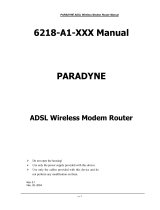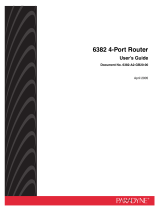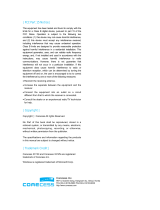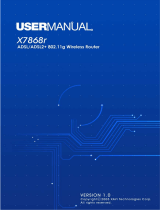Page is loading ...

1740 SHDSL
2/4-Wire Router
User’s Guide
Document Number 1740-A2-GB20-10
September 2004

1740 SHDSL 2/4-Wire Router User’s Guide
Copyright © 2004 Paradyne Corporation.
All rights reserved.
Printed in U.S.A.
Notice
This publication is protected by federal copyright law. No part of this publication may be copied or
distributed, transmitted, transcribed, stored in a retrieval system, or translated into any human or
computer language in any form or by any means, electronic, mechanical, magnetic, manual or otherwise,
or disclosed to third parties without the express written permission of Paradyne Corporation, 8545 126th
Ave. N., Largo, FL 33773.
Paradyne Corporation makes no representation or warranties with respect to the contents hereof and
specifically disclaims any implied warranties of merchantability or fitness for a particular purpose. Further,
Paradyne Corporation reserves the right to revise this publication and to make changes from time to time
in the contents hereof without obligation of Paradyne Corporation to notify any person of such revision or
changes.
Changes and enhancements to the product and to the information herein will be documented and issued
as a new release to this manual.
Warranty, Sales, Service, and Training Information
Contact your local sales representative, service representative, or distributor directly for any help needed.
For additional information concerning warranty, sales, service, repair, installation, documentation, training,
distributor locations, or Paradyne worldwide office locations, use one of the following methods:
Internet: Visit the Paradyne World Wide Web site at www.paradyne.com. (Be sure to register your
warranty at www.paradyne.com/warranty.)
Telephone: Call our automated system to receive current information by fax or to speak with a company
representative.
Within the U.S.A., call 1-800-870-2221
Outside the U.S.A., call 1-727-530-2340
Document Feedback
We welcome your comments and suggestions about this document. Please mail them to Technical
Publications, Paradyne Corporation, 8545 126th Ave. N., Largo, FL 33773, or send e-mail to
[email protected]. Include the number and title of this document in your correspondence. Please
include your name and phone number if you are willing to provide additional clarification.
Trademarks
Acculink, Bitstorm, Comsphere, DSL the Easy Way, ETC, Etherloop, FrameSaver, GranDSLAM,
GrandVIEW, Hotwire, the Hotwire logo, Jetstream, MVL, NextEDGE, Net to Net Technologies,
OpenLane, Paradyne, the Paradyne logo, Paradyne Credit Corp., the Paradyne Credit Corp. logo,
Performance Wizard, StormPort, TruePut are all registered trademarks of Paradyne Corporation.
ADSL/R, Connect to Success, Hotwire Connected, iMarc, JetFusion, JetVision, MicroBurst, PacketSurfer,
Quick Channel, ReachDSL, Reverse Gateway, Spectrum Manager, and StormTracker are trademarks of
Paradyne Corporation. All other products and services mentioned herein are the trademarks, service
marks, registered trademarks, or registered service marks of their respective owners.
CE Marking
When the product is marked with the CE mark on the equipment label, a supporting Declaration of
Conformity may be downloaded from the Paradyne World Wide Web site at www.paradyne.com. Select
Library → Technical Manuals → CE Declarations of Conformity.
2 September 2004 1740-A2-GB20-10

1740 SHDSL 2/4-Wire Router User’s Guide
Preface
This manual is designed to provide information to network administrators. It covers the installation,
operation and applications of the 1740 SHDSL router.
Warning
Before servicing or disassembling this equipment, always disconnect all power and telephone lines
from the wall outlet.
Use an appropriate power supply and a UL Listed telephone line cord. Specification of the power
supply is clearly stated in Appendix A - Specifications.
FCC Part 15 Declaration
An FCC Declaration of Conformity may be downloaded from the Paradyne World Wide Web site at
www.paradyne.com
. Select Support -> Technical Manuals -> Declarations of Conformity.
This device complies with Part 15 of the FCC Rules. Operation is subject to the following two conditions:
(1) this device may not cause harmful interference, and (2) this device must accept any interference
received, including interference that may cause undesired operation.
The authority to operate this equipment is conditioned by the requirement that no modifications will be
made to the equipment unless the changes or modifications are expressly approved by the responsible
party.
This equipment has been tested and found to comply with the limits for a Class B digital device, pursuant
to Part 15 of the FCC Rules. These limits are designed to provide reasonable protection against harmful
interference in a residential installation. This equipment generates, uses, and can radiate radio frequency
energy and, if not installed and used in accordance with the instructions, may cause harmful interference
to radio communications. However, there is no guarantee that interference will not occur in a particular
installation. If this equipment does cause harmful interference to radio or television reception, which can
be determined by turning the equipment off and on, the user is encouraged to try to correct the
interference by one or more of the following measures:
• Reorient or relocate the receiving antenna.
• Increase the separation between the equipment and receiver.
• Connect the equipment into an outlet on a circuit different from that to which the receiver is connected.
• Consult the dealer or an experienced radio/TV technician for help.
Notice to Users of the United States Telephone Network
This equipment complies with Part 68 of the FCC rules and the requirements adopted by the
Administrative Council for Terminal Attachment (ACTA). On the bottom side of this equipment is a label
that contains, among other information, a product identifier in the format US:AAAEQ##TXXXX. If
requested, this number must be provided to the Telephone Company.
This equipment is intended to connect to the Public Switched Telephone Network through a Universal
Service Order Code (USOC) type RJ11C jack. A plug and jack used to connect this equipment to the
premises wiring and telephone network must comply with the applicable FCC Part 68 rules and
requirements adopted by the ACTA. A compliant telephone cord and modular plug is provided with this
product. It has been designed to be connected to a compatible modular jack that is also compliant.
1740-A2-GB20-10 September 2004 3

1740 SHDSL 2/4-Wire Router User’s Guide
The Ringer Equivalence Number (or REN) is used to determine the number of devices that may be
connected to a telephone line. Excessive RENs on a telephone line may result in the devices not ringing
in response to an incoming call. In most but not all areas, the sum of RENs should not exceed five (5.0).
To be certain of the number of devices that may be connected to a line, as determined by the total RENs,
contact the local Telephone Company. The REN for this product is part of the product identifier that has
the format US:AAAEQ##TXXXX. The digits represented by ## are the REN without a decimal point. For
example, 03 represents a REN of 0.3.
If the modem causes harm to the telephone network, the Telephone Company will notify you in advance
that temporary discontinuance of service may be required. But if advance notice is not practical, the
Telephone Company will notify the customer as soon as possible. Also, you will be advised of your right to
file a complaint with the FCC if you believe it is necessary.
The Telephone Company may make changes in its facilities, equipment, operations or procedures that
could affect the operation of the equipment. If this happens, the Telephone Company will provide advance
notice in order for you to make necessary modifications to maintain uninterrupted service. If trouble is
experienced with the modem, refer to the repair and warranty information in this document.
If the equipment is causing harm to the telephone network, the Telephone Company may request that you
disconnect the equipment until the problem is resolved.
The user may make no repairs to the equipment.
Connection to party line service is subject to state tariffs. Contact the state public utility commission,
public service commission or corporation commission for information.
If the site has specially wired alarm equipment connected to the telephone line, ensure the installation of
the modem does not disable the alarm equipment. If you have questions about what will disable alarm
equipment, consult your Telephone Company or a qualified installer.
Notice to Users of the Canadian Telephone Network
NOTICE: This equipment meets the applicable Industry Canada Terminal Equipment Technical
Specifications. This is confirmed by the registration number. The abbreviation IC before the registration
number signifies that registration was performed based on a Declaration of Conformity indicating that
Industry Canada technical specifications were met. It does not imply that Industry Canada approved the
equipment.
NOTICE: The Ringer Equivalence Number (REN) for this terminal equipment is labeled on the equipment.
The REN assigned to each terminal equipment provides an indication of the maximum number of
terminals allowed to be connected to a telephone interface. The termination on an interface may consist of
any combination of devices subject only to the requirement that the sum of the Ringer Equivalence
Numbers of all the devices does not exceed five.
If your equipment is in need of repair, contact your local sales representative, service representative, or
distributor directly.
Canada – EMI Notice:
This Class B digital apparatus meets all requirements of the Canadian
interference-causing equipment regulations.
Cet appareil numérique de la classe B respecte toutes les exigences du réglement sur
le matérial brouilleur du Canada.
4 September 2004 1740-A2-GB20-10

1740 SHDSL 2/4-Wire Router User’s Guide
T
T
A
A
B
B
L
L
E
E
O
O
F
F
C
C
O
O
N
N
T
T
E
E
N
N
T
T
S
S
CHAPTER 1
OVERVIEW ....................................................................................... 8
1.1 Application...................................................................................................... 8
1.2 LED Indicators................................................................................................. 9
CHAPTER 2 INSTALLATION............................................................................... 10
2.1 Preparing for Hardware Installation .................................................................. 10
2.2 Rear-panel Connections .................................................................................. 11
CHAPTER 3 QUICK INSTALLATION ................................................................... 12
3.1 Login ........................................................................................................... 12
3.2 Web Page Layout ........................................................................................... 14
3.3 Monitoring the SHDSL Line.............................................................................. 15
3.4 WAN Interface Configuration ........................................................................... 17
3.5 Password Setup............................................................................................. 28
3.6 Setting the Bridge.......................................................................................... 29
CHAPTER 4 SETTING UP WAN AND LAN INTERFACES ....................................... 33
4.1 LAN Interface................................................................................................ 33
4.2 Configuring the WAN Interface......................................................................... 34
CHAPTER 5 SNMP ............................................................................................. 39
5.1 Enable SNMP................................................................................................. 39
5.2 Enable SNMP................................................................................................. 41
CHAPTER 6 PACKET FILTER .............................................................................. 42
6.1 Add a Packet Filter entry................................................................................. 43
6.2 Delete a Packet Filter entry ............................................................................. 44
6.3 Enable/Disable Packet Filter ............................................................................ 44
CHAPTER 7 ROUTING ....................................................................................... 45
7.1 Static Route .................................................................................................. 45
7.2 Set Up the RIP function .................................................................................. 47
7.3 Displaying the Routing Table............................................................................ 50
CHAPTER 8 NAT ................................................................................................ 51
1740-A2-GB20-10 September 2004 5

1740 SHDSL 2/4-Wire Router User’s Guide
8.1 Multiple to One.............................................................................................. 52
8.2 One to One NAT............................................................................................. 53
8.3 Multi-NAT ..................................................................................................... 54
8.4 Virtual Server................................................................................................ 56
CHAPTER 9 DHCP.............................................................................................. 57
9.1 DHCP Server ................................................................................................. 57
9.2 DHCP Relay................................................................................................... 58
CHAPTER 10 DNS PROXY ................................................................................... 59
CHAPTER 11 IGMP ............................................................................................. 60
CHAPTER 12 VLAN ............................................................................................. 62
CHAPTER 13 FAST BRIDGE................................................................................. 63
CHAPTER 14 MAINTENANCE AND DIAGNOSTICS................................................ 64
14.1 Software Upgrade and Configuration Backup /Restoration ................................. 64
14.2 OAM Loopback............................................................................................ 68
14.3 Ping .......................................................................................................... 69
14.4 Forwarding Table......................................................................................... 70
14.5 Routing Table ............................................................................................. 70
14.6 Performance Monitoring ............................................................................... 70
CHAPTER 15 APPLICATION EXAMPLE................................................................. 75
15.1 Adding the Static Route (Web) ...................................................................... 75
CHAPTER 16 PIN ASSIGNMENTS ........................................................................ 78
CHAPTER 17 CONSOLE ACCESS .......................................................................... 79
17.1 Login......................................................................................................... 79
17.2 Keyboard Operations ................................................................................... 80
17.3 Motoring the SHDSL Line Status.................................................................... 82
17.4 Password Setup .......................................................................................... 83
17.5 Retrieve the Factory Default Settings ............................................................. 83
17.6 Disable the Web Browser.............................................................................. 83
17.7 Save the Configurations ............................................................................... 84
17.8 Login......................................................................................................... 84
APPENDIX A: SPECIFICATIONS ............................................................................ 86
6 September 2004 1740-A2-GB20-10

1740 SHDSL 2/4-Wire Router User’s Guide
1740-A2-GB20-10 September 2004 7

1740 SHDSL 2/4-Wire Router User’s Guide
CHAPTER 1
1.1
Overview
The 1740 SHDSL router satisfies the needs of multiple users in small/home offices and remote/branch
offices. It provides symmetrical transmission speeds of up to 4.6 Mbps through a SHDSL connection, over
a two-wire or four-wire line. In addition, it supports up to 16 virtual concurrent connections to multiple
destinations. The integrated four-port switch enables up to four devices to be connected to the LAN.
The SHDSL router can be used for variety of applications, including video conferencing, remote training,
e-commerce, and other multimedia applications. Easy configuration and monitoring can be accomplished
using the Web browser.
The SHDSL router has full routing capabilities to segment/route IP protocol and is capable of bridging
other protocols. It can be also configured in either server or client mode enabling point-to-point
connectivity between two sites.
Application
The router can be used for DSLAM and point-to-point applications.
DSLAM Application
Point-to-Point Application
8 September 2004 1740-A2-GB20-10

1740 SHDSL 2/4-Wire Router User’s Guide
1.2 LED Indicators
There are eight LEDs on the front panel of the router; the functions of the LEDs are described in the table
below.
Figure 1-1 Faceplate LED Indicators
LED Color Mode Function
On Power is supplied POWER Green
Off Power is not supplied
Off No data transmitted or received over the Ethernet link
On The Ethernet link is established
LAN 1X–4X Green
Flash Transmitting or receiving data over Ethernet link
On The physical link through the RJ45 connection cable is
established
Flash The SHDSL line is training
SHDSL
LINK
Green
Off A SHDSL connection is not established
On Receiving data over the SHDSL link SHDSL RX Green
Off No data receiving over the SHDSL link
On Transmitting data over the SHDSL link SHDSL TX Green
Off No data transmitting over the SHDSL link
1740-A2-GB20-10 September 2004 9

1740 SHDSL 2/4-Wire Router User’s Guide
CHAPTER 2
2.1
Installation
Preparing for Hardware Installation
The following equipment may be necessary to install the router:
AC power adapter
A power adapter is shipped with the router.
LAN connection cable
To connect to the hub, use a straight-through RJ45 cable. To connect to a PC, use a crossover RJ45
cable.
Four-wire (8P8C) straight-through RJ45 cable
A four-wire (8P8C) straight through RJ45 cable is needed to connect to the LINE port to the wall outlet.
10 September 2004 1740-A2-GB20-10

1740 SHDSL 2/4-Wire Router User’s Guide
2.2 Rear-panel Connections
DSL connection
Connect the supplied RJ45 cable to the port marked LINE at the back of the SHDSL router. Connect the
other end of the cable to your telephone-line wall outlet. Ensure your computer is turned on before you
connect the DSL line to the router. A green LED on the front of the device labeled LINK will illuminate
steadily. If the SHDSL LINK LED does not illuminate steadily within one minute of it being connected,
check your cable connections to ensure they are correct and securely installed.
Ethernet connection
Insert one end of the RJ45 Ethernet cable into one of the LAN ports marked LAN on the back of the
SHDSL router. Connect the other end of the cable into your Ethernet Network Interface Card (NIC)
installed in your computer. When the Ethernet connection is established, the correspondent green LED on
the front panel labeled LAN will illuminate steadily. You can connect up to four PCs to the router.
Power connection
Connect the supplied external AC adapter into the DC power outlet on the back of the router. Connect the
power supply into your wall outlet or surge protector. Turn on the power switch. After powering on, the
router performs a self-test. Wait for a few seconds until the test is finished, then the router will be ready to
operate. The POWER indicator on the front of the router will illuminate green to indicate that power is
being supplied to the router.
Caution 1: If the router fails to power up, or it malfunctions, first verify that the power supply is connected
correctly. Then power it on again. If the problem persists, contact your technical support
representative.
Caution 2: Before servicing or disassembling this equipment always disconnect all power cords and
telephone lines from the wall outlet.
1740-A2-GB20-10 September 2004 11

1740 SHDSL 2/4-Wire Router User’s Guide
CHAPTER 3
3.1
Quick Installation
This section describes how to manage the router via the Web browser from the remote end. The Web
page is best read with a display resolution of 1024 x 768. To change the resolution, go to the Microsoft
Windows Control Panel and click on the Display icon. You will find the display settings there.
Login
STEP 1: Configure your workstation to the same network segment as the router, if for example the router
is set to its default address of 192.168.1.1, we could set the PC to 192.168.1.133 and subnet
mask 255.255.255.0.
STEP 2:
Start your Internet browser.
STEP 3:
Enter the IP address of the router in the Web address field. For example, if the IP address is
192.168.1.1, enter http:// 192.168.1.1
12 September 2004 1740-A2-GB20-10

1740 SHDSL 2/4-Wire Router User’s Guide
STEP 4: You will be prompted to enter your user name and password. Type your password, or if the
password was not changed, type the default passwords. The default ADMINISTRATOR user
name and password are root.
STEP 5:
After successfully logging in, you will reach the main configuration page. The left hand side has a
menu and the right side is blank.
1740-A2-GB20-10 September 2004 13

1740 SHDSL 2/4-Wire Router User’s Guide
3.2 Web Page Layout
On each Web page, there are two areas:
Menu Bar: On the left side of the Web page is the menu bar. It is divided into two parts: Basic and
Advanced. The Basic menu bar sets up the device for quick setup. The Advanced menu bar
configures advance functions such as SNMP, DHCP server, and DNS proxy. The menu also covers
the maintenance function.
Main Window: The main window in middle of the page displays after clicking a button on the menu
bar. It includes the tabs on the top of the window. The tabs lead to other sub-screens.
14 September 2004 1740-A2-GB20-10

1740 SHDSL 2/4-Wire Router User’s Guide
3.3 Monitoring the SHDSL Line
Click Link Status on the Basic menu bar. The Link Status screen has two tabs: SHDSL Status and
Performance. SHDSL Status is used to monitor the SHDSL link and the Performance is used to monitor
the SHDSL performance.
1740-A2-GB20-10 September 2004 15

1740 SHDSL 2/4-Wire Router User’s Guide
The following is the screen after clicking the [Performance] button.
16 September 2004 1740-A2-GB20-10

1740 SHDSL 2/4-Wire Router User’s Guide
3.4 WAN Interface Configuration
The router supports 16 ATM interfaces. A virtual channel (VC) can be configured for each ATM interface
such as ATM1 to VC1, ATM 2 to VC2, and so on. Each VC can be specified with a protocol, which can be
RFC 1483 bridged, RFC 1483 Routed, PPPoE, or PPPoA.
By default, VC1 is enabled with the parameters VPI/VCI 0/35 and protocol RFC 1483 Bridged. VC1 can
work without any modifications. VCs 2 to 16 are disabled.
If the VC is added on the Basic> Wan Setup, it will be added from VC2 to VC16. (VC1 is already enabled
for 0/35).
If a PPPoE-based VC is created on Basic>WAN Setup, the DHCP server will be automatically enabled. If
a PPPoE based VC is created on Advanced>Interface, the DHCP server function must be enabled
manually.
The WAN interface can be configured to operate in the following modes: bridge, router, PPPoE, or
PPPoA. Configuration for each mode is explained in the sections that follow.
3.4.1 Bridge Mode: Service for One Fixed IP Address
To configure one static IP address, you need to set up the VC in RFC 1483 Bridged mode. The router has
a default Virtual Channel (VC) of 0/35. It can function without other modifications.
1740-A2-GB20-10 September 2004 17

1740 SHDSL 2/4-Wire Router User’s Guide
STEP 1: Click WAN Setup on the Basic menu bar, and enter values for: VPI, VCI, Encapsulation (LLC or
VC MUX).
VPI Enter a value for the vitual path identifier
VCI Enter a value for the virtual channel identifier
LLCEncapsulation: With LLC encapsulation, a link control header is added to the Ethernet
packet that identifies the protocol type (Ethernet). This allows multiple
protocols to be transmitted over the ATM Virtual Circuit.
VC Multiplexing: With VC Multiplexing, no link control header is needed as the ATM
Virtual Circuit is assumed to be carrying a single protocol.
Enable NAPT This function cannot be set for bridge mode.
STEP 2:
Click on RFC 1483 Bridged.
STEP 3:
Click on the Add button. The new VC is added in the Current ATM PVC List on the bottom
screen.
To modify the VC, click a VC from the Current ATM PVC List to display the parameters of the VC.
Change its parameters and click on the Modify button.
3.4.2 Router Mode: Service for Five Static IP Addresses
To set up the service for five static IP addresses, you need to set up the VC in RFC 1483 Routed mode.
STEP 1:
Click WAN Setup on the Basic menu bar.
STEP 2:
Enter values for: VPI, VCI, Encapsulation (LLC or VC MUX), Enable NAPT.
VPI Enter a value for the vitual path identifier
VCI Enter a value for the virtual channel identifier
LLCEncapsulation: With LLC encapsulation, a link control header is added to the
Ethernet packet that identifies the protocol type (Ethernet). This
allows multiple protocols to be transmitted over the ATM Virtual
Circuit.
VC Multiplexing: With VC Multiplexing, no link control header is needed as the
ATM Virtual Circuit is assumed to be carrying a single protocol.
Enable NAPT
Selecting Enabling NAPT will enable Network Port Address
Translation on the WAN interface.
18 September 2004 1740-A2-GB20-10

1740 SHDSL 2/4-Wire Router User’s Guide
STEP 3: Click on the RFC 1483 Routed option.
STEP 4: Click on the Add button. The new VC is added in the Current ATM PVC List on the bottom
screen.
To modify the VC, click a VC from the Current ATM PVC List to display the parameters of the VC.
Change its parameters and click on the Modify button.
1740-A2-GB20-10 September 2004 19

1740 SHDSL 2/4-Wire Router User’s Guide
After creating an RFC 1483 Routed VC, click LAN Setup to set up the router’s Ethernet IP address.
After changing the IP address, click Apply to display the following screen. The Change & Reboot
button allows you to use the new IP address and reboot the router immediately. The Change button
allows using the IP address immediately but you need to save the setting by clicking Save & Reboot
on the Basic menu bar. To use the Web Browser, make sure you change the PC’s IP address.
20 September 2004 1740-A2-GB20-10
/









